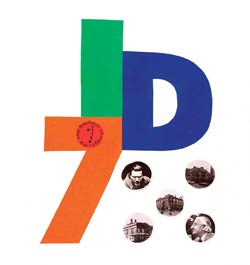
www.ivanchermayeff.com
In 1937, László Moholy-Nagy founded a cutting-edge design school in Chicago: the New Bauhaus. Rooted in a guiding principle behind Germany’s influential Bauhaus—that intelligent design could improve the world—the school attracted faculty and educated alumni who were iconic figures in photography, graphic design, and communications. Over the years, the New Bauhaus evolved to become the Institute of Design and made important strides in computer-supported design and product design.
Dean Patrick Whitney joined the Institute of Design in 1982 and became head of the school in 1986. Under his leadership, IIT ID has become one of the top graduate-level academic institutions in the world focusing on human-centered design, user research, and design strategy. In a conversation marking IIT ID’s 75th anniversary, Whitney discusses the past, present, and future of the school that has shaped design in Chicago and across the globe.
New Bauhaus Influence
While ID today does not carry on in the “craft” tradition of the New Bauhaus, what we do carry over is the belief in experimentation. Most design schools would say they do that, too, but our experimentation is broader, going beyond the arts. That spirit of experimentation has been evident through all of its 75 years. In the early years of the school, there was no formal research; it was all individual experimentation by faculty with marginal funding from companies and foundations. Today, it is much more evident to company and foundation leaders why ID’s approach is worth funding.
Growing into Leadership
We’ve achieved a significant number of milestones over the past 25 years. As the school began to develop increasingly advanced methods, a decision was made to close the undergraduate design program and focus on Ph.D. and master’s programs. This has evolved into numerous high-level offerings, including a two-year option for professional designers, a three-year option for those from other fields, a dual-degree Master of Design/M.B.A. program, and an executive format master’s for mid-career innovation leaders. Our most recent milestone is the short courses for executives. ID is one of only two or three schools that offer this type of program.
During this time, we grew research to the point where every tenured or tenure-track faculty member has outside funding to support their work. I’m sure we’re the only design school in the world that can say that.
Hometown Advantage
About only 10 percent of our students come from the Chicago area. But we’re a huge contributor to Chicago. If 10 percent of the students come from Chicago, probably 20 percent stay in Chicago after graduation, so we add to the growth of very bright people coming into the city. It’s one of the main ways that we contribute to Chicago—as a net contributor of talent. We bring an international flavor to the city.
Looking Toward the Future of Innovation
I think we’re in the earliest stages of the third Industrial Revolution, where we have seen information technology is augmenting old industrial processes, helping companies do things faster and cheaper. When the invention of photography was a new technology, it copied the forms of painting for decades before photography became its own medium. If you look at the first uses of television, it copied the forms of vaudeville. The first uses of computers were as calculating machines. All new technology in its first phase is used to help the old technology do things faster and cheaper. That’s how computing is being used now in manufacturing and in communications. Larger changes are on the horizon. One example is we will likely move from a consumer economy to a producer economy. People will be customizing the final product, information, or service for themselves. The designer’s role will change from designing final products and information, and instead focus on designing the systems to allow people to figure out the final product themselves.
From New Bauhaus to New Leader
All fields start out as informal practices of informal bodies of knowledge. We are one of the leaders in the world—certainly not the only one but one of the few schools in the world—that is building a body of knowledge, formalizing the body of knowledge, in the field of design.